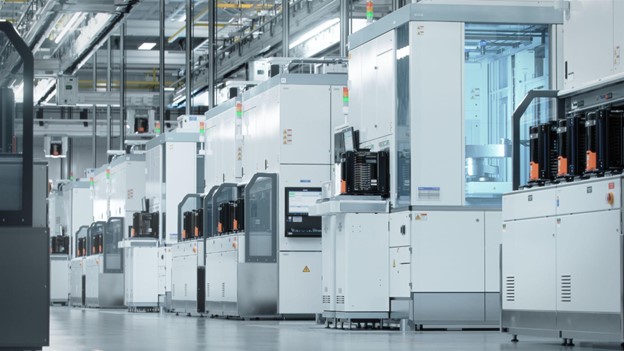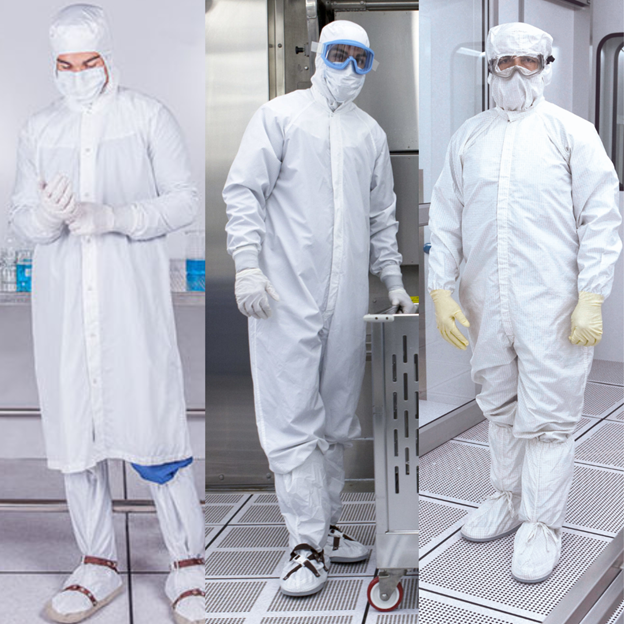Choosing the Right Cleanroom Garments and Products to Ensure Safe Work Environments
Cleanrooms provide businesses in a wide range of industries with a dedicated area designed for the safe handling and manufacture of a variety of sensitive products, but not everyone understands how these highly specialized rooms work. These rooms are controlled environments that are engineered to maintain low levels of airborne pollutants, such as dust, airborne organisms, and vaporized particles, that can harm certain types of delicate materials. They are used in scientific and industrial fields where even very small particles can adversely affect the manufacturing process.
Part of the cleanroom maintenance process is to ensure that literally anything entering the cleanroom—people or objects—won’t contaminate the environment. As a result, certain types of common workplace items, such as felt pens, are customarily banned from cleanrooms. Likewise, people entering these cleanrooms must wear appropriate cleanroom garments that protect the environment from natural contaminants that are constantly being emitted from humans (like skin particles, hair, etc.).
As cleanrooms are extremely sensitive environments, maintaining an acceptable level of airborne contaminants is a tougher task than you might think. That’s why it’s vitally important for workers in these areas to wear the right kinds of clothing. This is where a trusted cleanroom supplier, like Prudential Overall Supply (Prudential Cleanroom Services), is indispensable. Prudential Overall Supply has been offering high-quality industrial apparel since 1960, and has led the way in the work apparel industry—especially when it comes to cleanroom work uniforms.

Types of Cleanroom Garments and Supplies
In cleanroom environments, where the control of contamination is so important, the right garments and supplies are essential to maintain the functionality of the space. The types of apparel used in cleanrooms vary based on the specific needs and standards of the facility. Commonly used garments include coveralls, hoods, face masks, gloves, boots, shoe covers, and lab coats, all of them specifically engineered for cleanroom use. These items are designed to trap contaminants that naturally emanate from the skin and prevent them from entering the cleanroom environment.
Furthermore, each piece of clothing is made from materials that will not shed fibers or particles, such as polypropylene, and features special designs to limit the detachment of fibers and particles. The garments are usually lightweight and breathable to maintain comfort and functionality during extended use. They are also typically static-resistant as well.
In addition to apparel, cleanroom supplies include specialized cleaning products like sterile wipes, mops, and disinfectants that are designed to meet cleanroom standards. These kinds of cleanroom cleaning supplies are critical to maintaining a contaminant-free environment as they help to remove pollutants without introducing new ones into the area. Using these specialized cleanroom products on a routine basis goes a long way toward keeping the environment sterile and operational.
Cleanroom Garments: Keeping Work Environments Safer
Cleanrooms always serve essentially the same purpose: They prevent pollutants from harming the products being processed. However, specific cleanroom requirements vary according to the types of products that are handled in these areas. A specific type or concentration of airborne pollutants that may cause harm in one cleanroom might be perfectly safe in another. Examples of industry-specific cleanroom restrictions include:
- Pharmaceuticals – In pharmaceutical manufacturing, cross-contamination can lead to outcomes such as product recalls and health risks to patients. Impurities in medication can interfere with their efficacy or render them entirely unsafe for consumption.
- Semiconductor Manufacturing – The semiconductor industry demands exceptionally clean environments due to the micro-level precision required in chip manufacturing. Dust particles, even those invisible to the naked eye, can cause major defects in chips. This directly affects the reliability of technology that powers consumer electronics, automotive systems, and more.
- Aerospace – Aerospace components and assemblies require absolute precision, and any contamination can compromise the safety and functionality of critical aerospace systems. For example, optical sensors can be impaired by the presence of scratches or residues on their surface.
- Biotechnology – For the biotechnology industry, contamination can corrupt experimental data and cause inaccurate research outcomes. For example, stem cells can be easily harmed by contaminants like bacteria, fungi, or even microscopic particles.
- Optical Manufacturing – In the manufacture of lenses and other optical components, any particulate contamination—even at the microscopic level—can interfere with the clarity and performance of the final product. For that reason, the optical industry relies heavily on cleanroom environments to ensure that products meet stringent standards.
- Medical Device Manufacturing – Medical devices require very high standards of cleanliness to protect patient safety. Contamination can introduce bacteria or other pathogens into the body through medical devices, leading to infections and other serious health complications.
The use of high-quality cleanroom garment supplies is essential to address these risks and help cleanrooms function as they should.
Making Sure That Cleanroom Apparel Is Safe and Effective
Cleanrooms are categorized into different ISO classes that dictate the level of cleanliness required, which in turn determines the type of apparel necessary to maintain those standards. ISO refers to the International Organization for Standardization, which defines standards for cleanroom air purity through ISO 14644-1. This standard categorizes cleanrooms into classes based on the number of particles allowed per cubic meter.
ISO classes range from ISO 1, the most stringent, to ISO 9, the least stringent. ISO 1-2 cleanrooms are very uncommon due to the difficulty of maintaining them properly, and this classification is generally used only for the most demanding semiconductor and nanotechnology applications.
Each class has specific requirements for particle count, size, and air changes per hour. These requirements influence the types of garments considered appropriate for the environment, as follows:
- ISO 1-4: These classes represent the cleanest environments, typical in industries like semiconductor manufacturing and pharmaceutical compounding. Apparel for these classes includes full-body coveralls, intersuits, bouffant caps, hoods, gloves, boots, and face masks.
- ISO 5-6: Common in less critical areas of pharmaceutical, biotechnological, and medical device production, these classes still require a high level of cleanliness. Garments might include frocks or lab coats, bouffant caps, and shoe covers, which are less restrictive but still designed to control particulates effectively.
- ISO 7-8: Typically found in industrial manufacturing, these classes require gowns that prevent lint and control particulates but allow for more comfort and mobility compared to higher classifications. Shoe covers, face masks, and gloves are also generally required in these areas.
- ISO 9: Representing the least strict environments—which are nonetheless significantly cleaner than a normal workplace—this class tends to mandate simple cleanroom frocks and gowns or lab coats.
The choice of apparel material for cleanrooms varies according to the ISO class requirements, impacting both the level of cleanliness and worker comfort. Higher ISO classes (1-4), which demand stricter control over particulates, generally require clothing that is non-linting and has static dissipative properties. These materials are tightly woven or composed of synthetic fibers to minimize the shedding of particles and resist microbial penetration. For lower ISO classes (5-9), materials may offer more breathability and comfort but still provide adequate protection against contamination.
Selecting the correct type of cleanroom clothing is vital for maintaining the required environmental standards. The wrong type of clothing is by itself enough to compromise the safety of a cleanroom, even if all other procedures are followed to the letter. Understanding the specific ISO class requirements helps in choosing appropriate apparel that meets compliance standards and supports optimal operation and safety within the cleanroom.

Choosing the Right Cleanroom Supplier
Selecting the right supplier for cleanroom apparel is not a matter to be taken lightly. Prudential Uniforms stands out as a leader in the industry, providing world-class solutions for various cleanroom applications. Key features of Prudential’s products and services include:
- Diverse Apparel Solutions – Prudential offers a wide range of cleanroom garments designed to meet diverse industry standards. These garments are specially made for the stringent contamination control required in cleanroom settings. This includes specialized apparel like the NFPA 70E FR cleanroom garments, which are flame-resistant and designed to protect wearers in environments with electrical hazards while maintaining compliance with cleanroom cleanliness standards.
- Non-Garment Products – Prudential also offers a variety of non-garment products essential for maintaining cleanroom standards. These include reusable mops, goggles, and other useful supplies.
- Quality Cleaning Services – Prudential’s cleanroom garment cleaning services allow businesses to keep a fresh supply of apparel at all times. We provide garment laundering that adheres to cleanroom standards, ensuring that each piece of clothing remains functional over multiple uses. This service aids businesses in maintaining a high standard of cleanliness and compliance without the burdens of in-house laundering or costly single use disposable products .
- Flexible Acquisition Options – Prudential allows businesses to rent, lease, or purchase cleanroom uniforms. This flexibility allows businesses to choose a plan that best suits their budget and usage requirements.
- Expertise and Support – In business since 1960, Prudential’s expertise and experience with cleanroom clothing is unparalleled. We not only supply garments but also provide ongoing support that aligns with current industry standards and best practices.
Choosing Prudential Uniforms as your cleanroom clothing supplier means partnering with a provider that offers reliability, comprehensive service, and expert support. Our extensive catalog of cleanroom apparel, combined with top-notch garment care services and flexible purchasing options, ensures that your cleanroom operations can maintain the highest standards of cleanliness and safety.